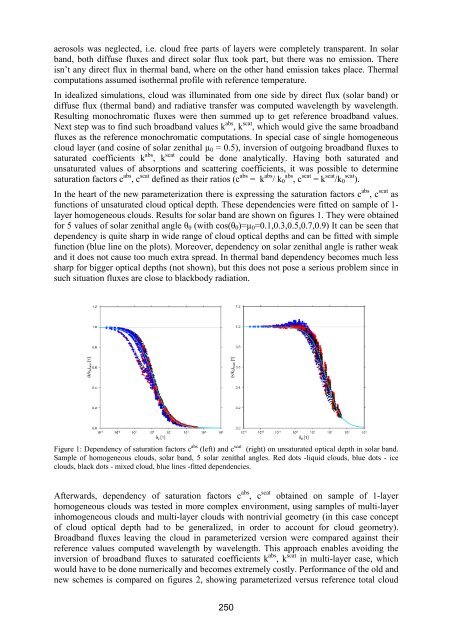Proceedings - C-SRNWP Project
Proceedings - C-SRNWP Project
Proceedings - C-SRNWP Project
Create successful ePaper yourself
Turn your PDF publications into a flip-book with our unique Google optimized e-Paper software.
aerosols was neglected, i.e. cloud free parts of layers were completely transparent. In solar<br />
band, both diffuse fluxes and direct solar flux took part, but there was no emission. There<br />
isn’t any direct flux in thermal band, where on the other hand emission takes place. Thermal<br />
computations assumed isothermal profile with reference temperature.<br />
In idealized simulations, cloud was illuminated from one side by direct flux (solar band) or<br />
diffuse flux (thermal band) and radiative transfer was computed wavelength by wavelength.<br />
Resulting monochromatic fluxes were then summed up to get reference broadband values.<br />
Next step was to find such broadband values k abs , k scat , which would give the same broadband<br />
fluxes as the reference monochromatic computations. In special case of single homogeneous<br />
cloud layer (and cosine of solar zenithal µ 0 = 0.5), inversion of outgoing broadband fluxes to<br />
saturated coefficients k abs , k scat could be done analytically. Having both saturated and<br />
unsaturated values of absorptions and scattering coefficients, it was possible to determine<br />
saturation factors c abs , c scat defined as their ratios (c abs = k abs / k abs 0 , c scat = k scat /k scat 0 ).<br />
In the heart of the new parameterization there is expressing the saturation factors c abs , c scat as<br />
functions of unsaturated cloud optical depth. These dependencies were fitted on sample of 1-<br />
layer homogeneous clouds. Results for solar band are shown on figures 1. They were obtained<br />
for 5 values of solar zenithal angle θ 0 (with cos(θ 0 )=µ 0 =0.1,0.3,0.5,0.7,0.9) It can be seen that<br />
dependency is quite sharp in wide range of cloud optical depths and can be fitted with simple<br />
function (blue line on the plots). Moreover, dependency on solar zenithal angle is rather weak<br />
and it does not cause too much extra spread. In thermal band dependency becomes much less<br />
sharp for bigger optical depths (not shown), but this does not pose a serious problem since in<br />
such situation fluxes are close to blackbody radiation.<br />
Figure 1: Dependency of saturation factors c abs (left) and c scat (right) on unsaturated optical depth in solar band.<br />
Sample of homogeneous clouds, solar band, 5 solar zenithal angles. Red dots -liquid clouds, blue dots - ice<br />
clouds, black dots - mixed cloud, blue lines -fitted dependencies.<br />
Afterwards, dependency of saturation factors c abs , c scat obtained on sample of 1-layer<br />
homogeneous clouds was tested in more complex environment, using samples of multi-layer<br />
inhomogeneous clouds and multi-layer clouds with nontrivial geometry (in this case concept<br />
of cloud optical depth had to be generalized, in order to account for cloud geometry).<br />
Broadband fluxes leaving the cloud in parameterized version were compared against their<br />
reference values computed wavelength by wavelength. This approach enables avoiding the<br />
inversion of broadband fluxes to saturated coefficients k abs , k scat in multi-layer case, which<br />
would have to be done numerically and becomes extremely costly. Performance of the old and<br />
new schemes is compared on figures 2, showing parameterized versus reference total cloud<br />
250

















